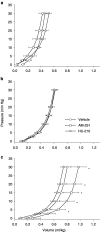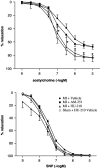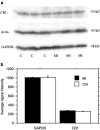CB(1) cannabinoid receptor antagonism promotes remodeling and cannabinoid treatment prevents endothelial dysfunction and hypotension in rats with myocardial infarction
- PMID: 12711625
- PMCID: PMC1573770
- DOI: 10.1038/sj.bjp.0705156
CB(1) cannabinoid receptor antagonism promotes remodeling and cannabinoid treatment prevents endothelial dysfunction and hypotension in rats with myocardial infarction
Abstract
1. To study the long-term effects of altered cannabinoid receptor activity on myocardial and vascular function, Wistar rats were treated with the selective CB(1) antagonist AM-251 (0.5 mg kg(-1) d(-1)), the potent synthetic cannabinoid HU-210 (50 micro g kg(-1) d(-1)) or vehicle for 12 weeks after coronary artery ligation or sham operation. 2. AM-251 further reduced the pressure-generating capacity, shifted the pressure volume curve to the right (P<0.05) and increased the left-ventricular operating volume (AM-251: 930+/-40 micro l vs control: 820+/-40 micro l vs HU-210: 790+/-50 micro l; P<0.05) in rats with large myocardial infarction (MI). 3. Left-ventricular CB(1) immunoactivity in rats 12 weeks after large MI was unaltered as compared with noninfarcted hearts. 4. Cannabinoid receptor activation through HU-210, a cannabinoid that alters cardiovascular parameters via CB(1) receptors, increased the left-ventricular end-diastolic pressure (LVEDP, P<0.05). However, it prevented the drop in left-ventricular systolic pressure (HU-210: 142+/-5 mm Hg; P<0.05 vs control: 124+/-3 mm Hg; and P<0.001 vs AM-251: 114+/-3 mm Hg) and prevented endothelial dysfunction (ED) in aortic rings of rats with large MI (P<0.05). 5. Compared with AM-251, HU-210 prevented the decline in the maximal rate of rise of left-ventricular pressure and the maximum pressure-generating ability (P<0.05). In rats with small MI, HU-210 increased cardiac index (P<0.01) and lowered the total peripheral resistance (P<0.05). 6. The study shows that during the development of congestive heart failure post-large MI, cannabinoid treatment increases LVEDP and prevents hypotension and ED. Presumed CB(1) antagonism promotes remodeling despite unchanged myocardial CB(1) expression.
Figures




Comment in
-
Endocannabinoids as mediators in the heart: a potential target for therapy of remodelling after myocardial infarction?Br J Pharmacol. 2003 Apr;138(7):1183-4. doi: 10.1038/sj.bjp.0705155. Br J Pharmacol. 2003. PMID: 12711614 Free PMC article.
References
-
- BAUERSACHS J., BOULOUMIE A., FRACCAROLLO D., HU K., BUSSE R., ERTL G. Endothelial dysfunction in chronic myocardial infarction despite increased vascular endothelial nitric oxide synthase and soluble guanylate cyclase expression: role of enhanced vascular superoxide production. Circulation. 1999;100:292–298. - PubMed
-
- DEVANE W.A., HANUS L., BREUER A., PERTWEE R.G., STEVENSON L.A., GRIFF C., GIBSON D., MANDELBAUM A., ETINGER A., MECHOULAM R. Isolation and structure of a brain constituent that binds to the cannabinoid receptor. Science. 1992;258:1946–1949. - PubMed
-
- FLETCHER P.J., PFEFFER J.M., PFEFFER M.A., BRAUNWALD E. Left-ventricular diastolic pressure–volume relations in rats with healed myocardial infarction: effects on systolic function. Circ. Res. 1981;49:618–626. - PubMed
Publication types
MeSH terms
Substances
LinkOut - more resources
Full Text Sources
Other Literature Sources
Medical

